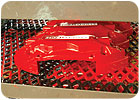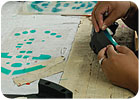Fast Masking

“We couldn’t do it,” says Michael Graves of Hytech Processing, referring to a high-performance automotive brake caliper coating project that required complex masks to protect curved, contoured surfaces.
“We needed to mask the calipers in a specific way. Applying tape by hand and cutting away the excess was taking too long for us to meet our deadlines,” he adds.
Hytech Processing is an Inglewood, CA-based custom coating firm that coats products for a range of applications, including the automotive industry. A customer brought the company a difficult brake caliper project - and a set of demanding deadlines. The high-end automotive brake calipers - destined for installation on expensive, semi-custom automobiles - needed a specific finish pattern to highlight the shape and the brand name. Because the parts were cast in curved, three-dimensional shapes, standard die-cut mask shapes simply couldn’t do the job.
Unfortunately, hand-applying masking tape and then cutting away the unwanted tape with a sharp knife consumed more than 15 minutes of operator time for each brake caliper, and that was with Hytech’s most experienced masking operators. The company’s less experienced workers needed even more time.
Hand masking each caliper was causing a production bottleneck, and throughput issues threatened Hytech’s ability to take on and complete the lucrative but time-limited project. Was it simply a job out of reach?
“It was killing us,” says Graves, “until I called my masking supplier.”
Prototypes in Two Days
Tom Diaz is a sales representative for Shercon, a Southern California-based masking products supplier. After receiving Graves’ call, Diaz visited Hytech the next day, inspected the calipers, toured the production process, and thought Shercon could solve Hytech’s production bottleneck.Diaz took a sample caliper back to Shercon’s Victor Mares, one of Shercon’s design engineers, and returned only a day later with a prototype die-cut masking set.
“I wasn’t really pushing him,” says Graves of Shercon’s Diaz. “They just turned it around right away.”

Die-Cut Masks 101
Die-cut masks are routinely used to prevent finish deposition on product surfaces during wet paint, powder coat and e-coat processes. They can be as simple and “low-tech” as a single strip of masking tape applied to a flat surface before wet paint is applied, or as high-tech as a custom-developed, ergonomically designed mask that protects a complex, three-dimensional surface from a nine-stage coating process.Most masks are produced when shaped dies “punch” a shape onto a masking substrate. In this case, Shercon created prototypes using a custom-developed software/cutting solution.
The real benefit of die-cut masks is their “peel-and-stick” simplicity; operators only have to position the masks (alignment features can be built into the mask to aid positioning), and the results are typically extremely consistent.
The Benefits of a Masking Kit
To produce the custom die-cut prototype masking kit quickly, Shercon’s Victor Mares carefully measured and inspected the brake caliper, sketched it using 3D CAD software, and devised a set of custom die-cut masks that could be simply stuck to the part, and just as easily peeled away after the part had been coated.“I’ve seen this plenty of times,” says Mares. “Cast, machined parts are difficult to mask because they’re usually not symmetrical, and these brake calipers contained contoured surfaces.”
Complex jobs often require several masks. Rather than produce each mask individually, Mares opted to create a masking kit - a set of masks on a single substrate. Similar to a set of decals found in a model airplane kit, only with peel-and-stick convenience, a masking kit solves several inventory and quality assurance problems. For example, if a project requires six different die-cut masks, running out of only one mask means that operators will have to revert to slow hand-masking techniques. Put all six die cuts on a single masking sheet, and inventory is now as easy as matching the number of masking kits to the number of parts in production.
“Masking kits are an excellent - and underutilized - idea,” adds Diaz. “Masking kits also provide an extra quality assurance check. If a mask doesn’t get applied, it’s a lot cheaper to spot the leftover mask on the sheet before sending the part down the line and ruining it.”

Right into Production
Shercon’s initial masking set prototype was tested at Hytech the day after Diaz’s initial visit. After two rapid iterations for minor changes, the brake caliper masking kit was put into production. To meet tough deadlines, Shercon developed and refined a sophisticated workflow process designed to speed turnarounds of custom/prototype die-cut masks.“We tried the prototypes, made small changes, and it went right into production,” says Graves.
The mask application time per brake caliper dropped from 15 minutes to 1-2 minutes, eliminating the job’s most significant production bottleneck.
“In fact, once we saw how effective Shercon’s masking kit was on our line, we ordered a year’s supply,” says Graves.
Graves mentioned that he’d never used a custom mask solution before. However, he notes, “I’m certainly going to look a lot closer at the jobs as they come in. The savings in time and productivity were huge, and they far outweighed the costs of the mask.”
In addition to the productivity benefits, Graves outlined the following ancillary benefits of the custom die-cut masking kit:
- Greater product finish consistency (eliminated differences in how operators hand-cut masks)
- Better quality assurance (fewer missing/misapplied masks)
- Easier mask inventory
“Tom and Victor did a great job,” says Graves. “I’m getting ready to order next year’s supply.”
For more information about masking, contact Shercon Inc., Cypress, CA, 800.228.3218 or 714.548.3999, or visit the company's website at www.shercon.com. Additional information about Hytech Processing can be found at www.hytechprocessing.com, or by calling the company at 310.673.5532.
SIDEBAR: Should You Consider Custom Masking?
Rapid turnarounds on custom masks have become the norm for Shercon’s Diaz, who starts thinking about custom solutions whenever he walks into a coating shop and sees masking operators holding knives.“Any time you’re applying tape and then removing part of it, you could be a candidate for a custom mask,” he says, adding that the transition to a custom kit removes most operator error from the process.
“What happens if your most skilled masker is out for a couple weeks and productivity plummets?” he adds.
Given that high throughput and crushing deadlines are becoming increasingly common for both in-house finishing shops and custom coaters, custom die-cut masks can offer real benefits, especially when they’re used to solve problems currently being handled with hand application and removal of tape.
Additionally, custom die-cut masks can be developed to solve almost any production coating problem. For example, Shercon often adds pull tabs to custom masks slated for application in small spaces, thereby speeding operator application and removal.
“It’s easy to forget that you’ve got to take masks off as quickly as you apply them,” says Mares. “Adding something as simple as a pull tab can have a significant effect on productivity, especially on high-volume coating lines.”
Looking for a reprint of this article?
From high-res PDFs to custom plaques, order your copy today!



